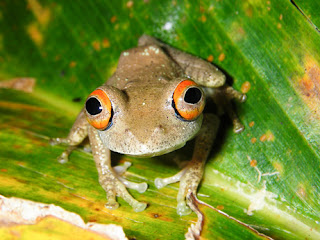On the back of this weeks video series segment, our photo of the week is of the strange and curious aye aye.
 |
Aye aye
|
The aye aye is highly adapted to its native Malagasy home with mind boggling features such as bat-like ears which can detect insect larvae squirming inside trees and a bark breaking bite from strong incisor teeth. They use their long, probing second finger to then excavate its fleshy insect meal.
However, the aye aye is a species wrapped up in mysticism and superstition as the Malagasy see its elongated finger as a harbinger of death. Villagers actively hunt the aye aye partly due to their beliefs but also for their meat. Nevertheless, the aye aye's greatest threat is from deforestation and is currently listed on the World Conservation Union's Red List of Threatened Species.
Captive breeding programmes are in action in an attempt to bolster numbers and provide education on this unique species. The first captive bred infant aye aye in the UK was born at the Bristol Zoo Garden in 2005. Why go along and check it out? More information is available here....
http://www.bristolzoo.org.uk/aye-aye


